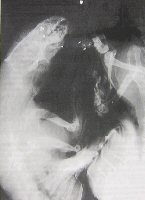 |
Last Update:
Thursday November 22, 2018
|
| [Home] |
|
Volume 11 Pages 1 - 57 (April 1995) Citation: Gutleb, A.C., Henninger, W., Loupal, G. and Kranz, A. (1995) Evidence for Illegal Attempts to Kill Otters (Lutra lutra) in Austria . IUCN Otter Spec. Group Bull. 11: 10- 13 Evidence for Illegal Attempts to Kill Otters (Lutra lutra) in Austria A.C. Gutleb1, W. Henninger2, G. Loupal3 and A. Kranz4 1 Institute
of Medical Chemistry, University of Veterinary Medicine, Linke Bahngasse
11, A-1030 Vienna
The otter (Lutra lutra) is fully protected under hunting laws in most European countries (MACDONALD and MASON, 1990). Nevertheless there is some evidence for illegal hunting and lead pellets were found in animals (MADSEN et al., 1994; TOMAN, 1995). In Austria there are attempts to collect all otters found dead, although dead otters belong principally to the hunters. The number of known cases of dead otters is increasing over the past years and most of the carcasses were given to us. On all these carcasses necropsy including x-ray, histopathology, bacteriology, virology and parasitology is conducted. Whenever possible the age of the animal is determined following the method of HEGGBERGET (1984). 17 otters found dead (1989-1993) were collected and stored deepfrozen prior to further examination. On all otter carcasses x-rays have been carried out. In two otters both from the Waldviertel, the main area of otter distribution in Austria (GUTLEB, 1994), fragments of bullets were found in the x-rays. Case 1: A male animal, about 9 years old, was slain with a wooden stick on the court of a farm (8.1.1993). The man claimed his fear from rabies as the reason to kill the animal. Though the otter had non suppurative encephalitis, rabies could be excluded by immunohistology. Radiographic findings: lead shotgun pellets were seen caudal and near to the left jaw joint, at the base of the right orbit, at the caudal aspect of the 13th thoracic vertebra, and at the cranial articular processes of the 7th lumbar vertebra. Various fragments of bullets of 6x7 mm respectively 7x4 mm in size and irregular contours could be seen in the mid of the right orbit and at the distal and cranial edge of the right tibia. Superimposed to the skull and the left hind paw many very small fragments of bullets - abrasions - were found. Fractures of the right zygomatic arch, the right branch of the mandible and of the bones of the calvaria could be detected. Bilateral omarthrosis and spondylosis could be seen (Fig. 1). Necropsy: In the subcutis of head and neck there were multiple large haemorrhages. In addition to the fractures demonstrated in the x-ray we found multiple fissures in the neurocranium. The fragments of the bullets lay in the tissue without any reaction.
Case 2: A male otter (age not determined yet) was found dead near a road (21.4.1993). The animal obviously had died after a collision with a car. Radiographic findings: a 7x8 mm large square fragment of a bullet with
irregular contours was found in the 9th intercostal space. Another
smaller fragment 4x3 mm in size could be seen superimposed to the
lateral end of the 10th rib, another very small amount at the 6th
rib. Pneumothorax was detected in both pleural spaces. The abdominal
structures were not clearly visible due to suspected intraperitoneal
fluid. Fracture of the pelvis was obvious, luxation of the iliosacral
joint could not be excluded, but no alteration on vertebrae and ribs
was seen. Necropsy: While the abdominal cavity was completely filled with blood, there was only a slight haemothorax. In the pelvic region we found severe haemorrhage in the muscles additional to the lesions seen in x-ray. Again there was no reaction around the fragments of the bullets. Both animals died because of traumatic insults (one animal was slain, the other died after a collision with a car). As in both cases the fragments of the bullets lay in the tissue without any reaction it is proved that the animals did not die due to the shots. In addition the lead levels in liver and kidney of the two animals were far beyond what is assumed to be critical for mammals. Mobilization of lead from the pellets had therefore not occurred. The otter of case 1 had fragments of two different sorts in its body. So it must be assumed that this animal had been wounded twice. Although it is forbidden to hunt otters throughout the whole year the finding of two animals with pieces of metals in their body gives a strong indication for illegal hunting practice REFERENCES Gutleb, A. C. (1994). Todesursachenforschung
Fischotter - Grundlage für ein Schutzkonzept von Lutra lutra
(L. 1758). Forschungsbericht Fischotter 2, WWF-Forschungsbericht 11:
12-25. |
| [Copyright © 2006 - 2050 IUCN/SSC OSG] | [Home] | [Contact Us] |
